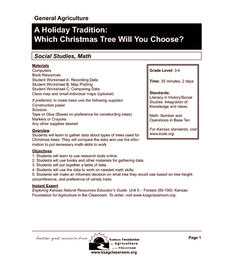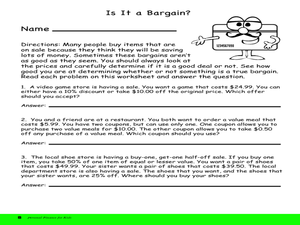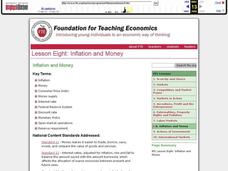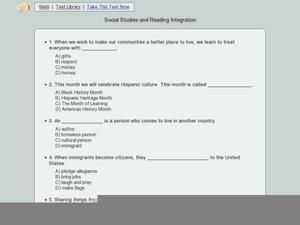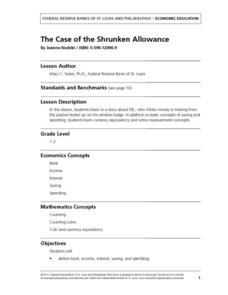Council for Economic Education
Paper Money of the Sung, Yuan, and Ming Dynasties
Why did the Chinese develop paper money? They were the first society to use paper currency. Learners consider why paper money was more convenient than other mechanisms of trade using a helpful lesson plan, which includes a graphic...
Agriculture in the Classroom
A Holiday Tradition: Which Christmas Tree Will You Choose?
Different varieties of Christmas trees provide an interesting way to combine social studies, science, math, and technology. Class members not only research the history of the Christmas tree holiday tradition, they compare and contrast...
Curated OER
How Do You Spend Your Money?
Fifth graders examine ways to save and spend money. They look at ways that people earn, save, and spend money using chapters from Tom Birdseye's Tarantula Shoes. They add and subtract decimals to fill in a worksheet entitled, "Is It a...
Federal Reserve Bank
Keep the Currency
Each day, people throw currency away in different ways because of a lack of financial knowledge. Introduce your learners to the importance of financial literacy and assess their understanding of banking and personal finance.
Curated OER
What can money tell us?
Students study the physical presence, imagery and written text on a reproduction of colonial currency. They apply their research to a modern day quarter to compare and contrast two coins. In addition, they design their own colonial...
Curated OER
Lesson: More Than a Dollar's Worth of Meaning
The Chinese, Dish with the Eight Buddhist Emblems contains symbols and visual references for learners to explore. They search for Buddhist symbolism on the dish and then they use their observation skills to locate and explore the meaning...
Curated OER
Currency and the Fed
Students take a closer look at money. In this federal reserve lesson, students complete the provided handouts that require them to examine Federal reserve notes and discover details about the role of the Federal Reserve in the United...
Curated OER
Chapter 14: How Banks and Thrifts Create Money
Teach your class about the value of a dollar in this economics presentation, which details the inner-workings of commercial banks. From reserve requirements to money expansion, these slides will clear up any misconceptions about "the...
Federal Reserve Bank
The Fed Is Protecting Your Money
A dollar bill, a check, a credit card, and... a cow? What exactly are the various forms of payment that exist today? Your learners will identify the three functions of money in this lesson. In addition, they will discover the most common...
Curated OER
Taxes in U.S. History: The Social Security Act of 1935
High schoolers explain the history of the Social Security Act and the FICA tax. They describe what Social Security is and whom it is intended to help. They explain the purpose of the FICA tax.
Curated OER
Producers, Consumers, Goods and Services
Second graders explore producers and consumers. In this social studies lesson plan, 2nd graders read a story and discuss the concept of producers, consumers, goods and services. Students portray various roles and discuss if they are a...
Curated OER
Inflation and Money
Students examine the relationship between inflation and money. Defining key terms, they define money in terms of its functions and give examples of money. They discover what happens when inflation occurs unexpectedly. They also examine...
Curated OER
The History of Paper Money
Learners research the history of paper money using the Internet in order to answer questions and create their own bills.
Curated OER
Social Studies and Reading Integration
Kids take a quiz on the concepts that define community and culture. They answer 10 multiple choice questions regarding family traditions, immigration, Hispanic culture, and community.
Federal Reserve Bank
Ben Franklin: Highlighting the Printer
By studying Benjamin Franklin's work as a printer, your class will have a fantastic opportunity to learn about the economic concepts of entrepreneurship, human capital, and investment.
Curated OER
Hooray for Hand-Me-Downs!
Youngsters learn how "hand-me-downs" can help save money while practicing math word problems with this fun learning center activity.
Federal Reserve Bank
The Case of the Shrunken Allowance
An allowance is an important thing! Make sure your kids know how to save and spend their own money. Using the book The Case of the Shrunken Allowance as a starting point, this plan covers income, spending and saving, counting, and more.
Mrs. Robbins' Social Studies Site
The Berlin Blockade
The Berlin Blockade may not take up as much space in the history books as other events of the Cold War, but for the citizens of west Berlin in 1948—and the events to follow between the Soviet Union and the United Stattes—those 318 days...
Missouri Department of Elementary
How Much Does Smoking Really Cost?
Following a brief survey about tobacco, scholars examine a fact sheet to answer questions about the substance. A practice page challenges the class to determine the cost of the habit using money math. Pupils discuss their findings...
Curated OER
Money Is What Money Does
Everybody loves to discuss money. Using this money-related resource learners read background information, and discuss how well certain items would perform as a medium of exchange based on the function of money.
Federal Reserve Bank
Something Special For Me
People often save money, but what are the benefits and drawbacks of that action? Youngsters learn about saving, savings, and opportunity cost through the lens of a short book, called Something Special for Me.
iCivics
Campaign Cash: Money Talks!
Money talks! And it can reveal a lot about political candidates. An 11-slide presentation examines how candidates raise and spend money on an election. The slides, using data from the 2016 Presidential election, reveal how much it costs...
US Mint
Symbols in My Eyes
Explore the hidden meanings behind the images on US currency with this elementary school lesson on symbolism. Starting with a class discussion about symbols, children go on to brainstorm different objects that represent the Unites States...
Curated OER
Musical Change
Young learners record observations about different coin denominations and create a song about coins to the traditional song, "The Wheels on the Bus." This instructional activity is based on the Tennessee Quarter Reverse, and has all...



